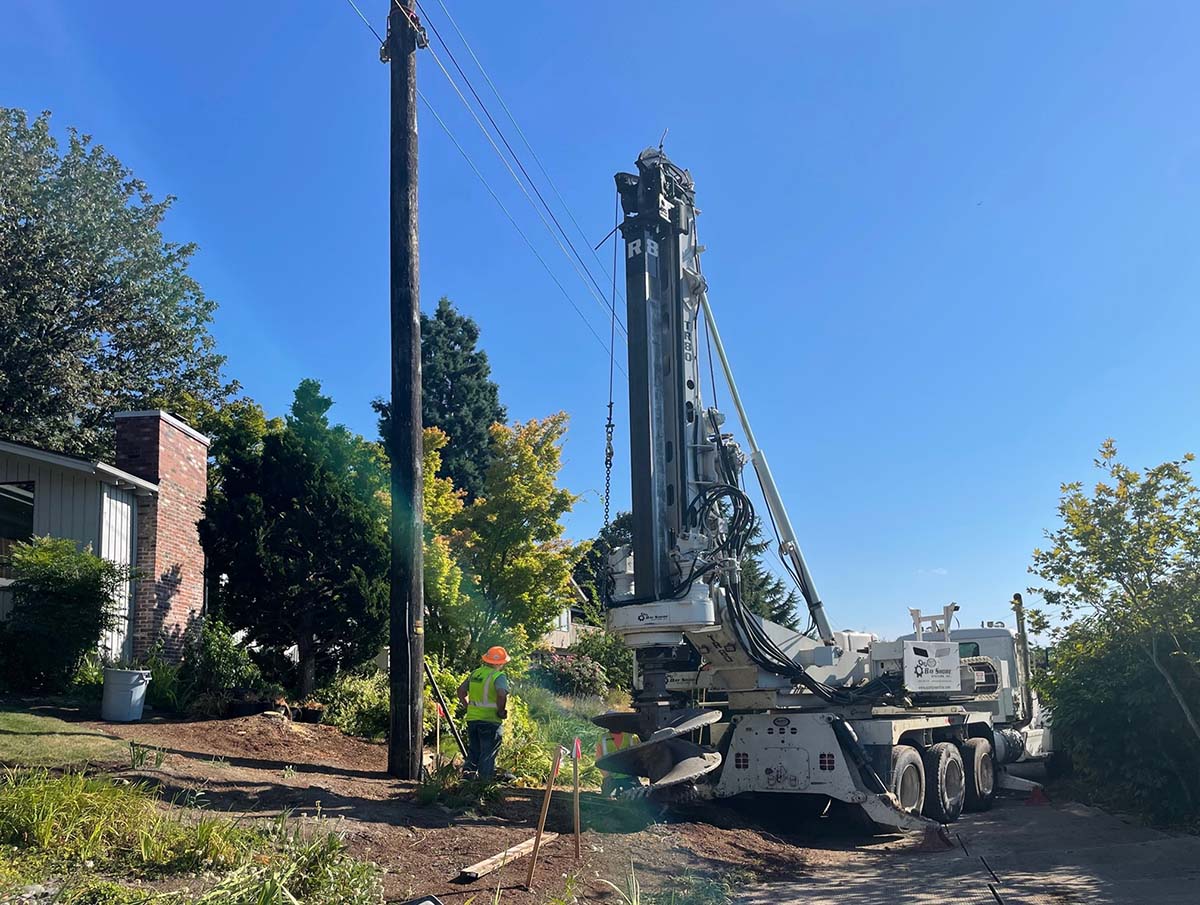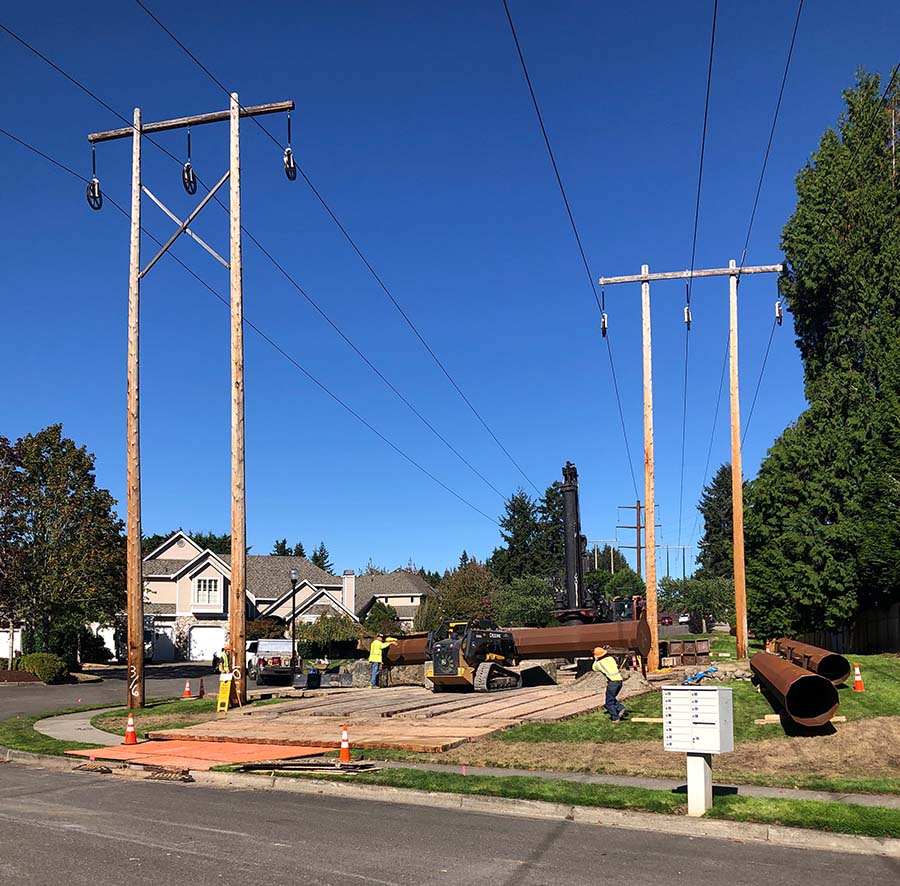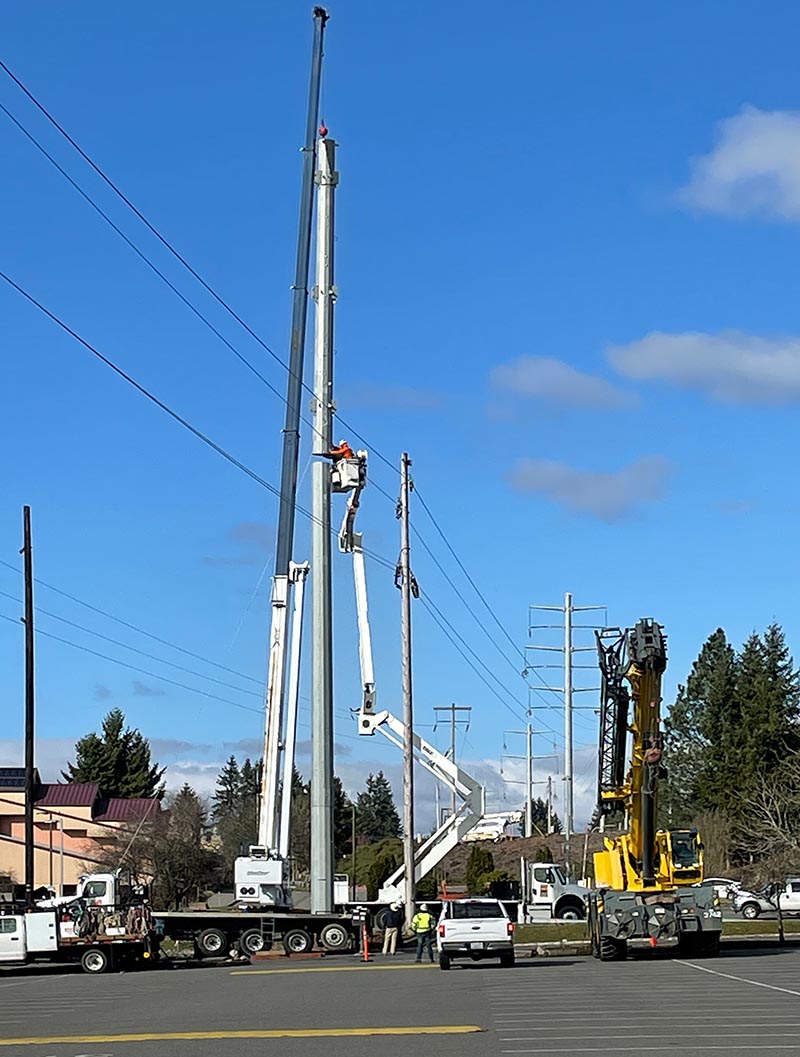Construction
Construction and safety
PSE approaches every project with the same priority: the safety of our customers, the communities we work in, and our fellow co-workers. Learn more about Safety.
Transmission line construction is now complete on the southern portion of the line. The new transmission lines from Renton to south Bellevue and the new Richards Creek substation are now energized. Construction has begun on the north half of the transmission line in Redmond and north Bellevue and will continue through 2024. For more information on activities at Richards Creek Substation and transmission line construction, click on the drop-down titles below.
Review our construction fact sheet to learn more.
 PSE began construction of the new Richards Creek substation in September 2020. The new substation is a critical component of PSE’s 16-mile Energize Eastside project.
PSE began construction of the new Richards Creek substation in September 2020. The new substation is a critical component of PSE’s 16-mile Energize Eastside project.
Once connected to the upgraded transmission lines, the new substation’s transformer will meet area service capacity and reliability needs to power Eastside homes and businesses into the future.
The project has undergone years of study, community dialogue, environmental review and permitting. Construction activities will be conducted consistent with all applicable federal, local and state requirements and permits, including Bellevue codes and the Energize Eastside South Bellevue Conditional Use Permit Conditions of Approval dated June 25, 2019.
The new substation is being built at PSE’s property at 13600 SE 30th Street in Bellevue (see map).
Questions? Contact us:
Construction infoline: 1-800-548-2614, Ext. 2
Email address: energizeeastside@pse.com
As always, the safety of our customers, employees and service providers remains our top priority. In the field, PSE and service provider crews adhere to all statewide and corporate COVID-19 safety requirements. To ensure safety, our crews continue to maintain social distancing with customers in the field, and we ask our customers to do the same.
PSE is proud to serve your community and we aim to complete the work safely, efficiently, and in a way that minimizes disruptions. We will keep the local community informed before, during and after construction so you know what to expect while we are working in the area.
What will the new substation do?
The new substation will contain a new 230 kilovolt (kV) transformer to meet area service capacity and reliability needs. Once connected to the upgraded transmission lines, the new transformer will step down power voltage from 230 kV to 115 kV, where it will then be delivered via existing and future 115 kV transmission lines to power Eastside homes and businesses.
What kinds of construction activities are needed to build it?
Construction at the site entails a variety of activities:
- Civil construction and site preparation
- Installation of substation facilities
- Restoration
PSE will implement measures to alleviate construction and permanent project impacts, including Best Management Practices for stormwater and excavation activities.
What can neighbors who live and work nearby expect?
Most activities will occur on the Richards Creek substation site and SE 30th Street will be used to haul equipment and materials. Neighbors and nearby businesses may notice typical noise from construction equipment, vehicles and machinery, though the work that would create the most noise has now been completed. Work will typically occur Monday through Fridays, between 7 a.m. and 6 p.m. In some cases, weekend work may be necessary on Saturdays from 9 a.m. to 6 p.m.
What is PSE doing to restore the area after construction?
As part of this construction project, PSE will replant trees, including native trees like Western red cedar, Sitka spruce and willows. We will also conduct stream restoration and enhance wetlands.
Transmission line construction is complete on the southern portion of the line in Renton, Newcastle and south Bellevue. Construction is ongoing on the north half of the line in Redmond and north Bellevue. Construction activities for transmission lines include:
- Pre-construction surveying
- Site preparation (including vegetation removal) and access
- Construction of the new poles and removal of old poles
- Stringing the conductors (wires)
- Demobilization, clean-up and restoration
See our Construction Life Cycle graphic for more details on the phases of construction.
Working with property owners
As we know more about construction timing and details, we will keep property owners informed of the schedule and activities.
We are meeting with affected property owners to discuss our construction plans. We are working with property owners to minimize impacts during construction as much as practicable.
Pre-construction surveying
PSE began collecting field information in 2015 to inform the environmental review process, as well as project design and permit applications. The fieldwork conducted included a variety of surveys completed by PSE crews and industry experts investigating on-the-ground characteristics of a particular location.
PSE develops, designs and constructs electric transmission projects in accordance with all applicable federal, state and local codes and regulatory requirements. Our engineering and construction principles are consistent with industry standards.
Identifying access and pole locations
Crews routinely access the corridor today for inspections, maintenance and other needs. Where possible, construction crews will generally use the same access paths used today. In some situations, crews may need to establish new access points. If any new access is necessary, PSE will meet directly with affected property owners to discuss changes and use best construction methods to minimize impacts.
The new poles will typically be located in approximately the same or similar locations as existing poles.
PSE considers a variety of factors when siting poles, including:
- Safety and technical considerations, including electrical clearances, varying terrain, structural loading, and code requirements
- Critical areas, like wetlands or streams
- Other utility uses in the corridor
- Property lines and easement locations
- Property owner considerations
Site preparation
Prior to construction, crews will stake the right of way and critical areas, construct access routes to the pole sites, and trim or clear vegetation on the right of way. Vegetation within a utility corridor must be managed to comply with federal requirements to ensure safe, reliable power.
Construction
During construction, work on individual properties will take place in phases. The construction team may visit a property for up to a few days at a time over several weeks or months before construction is complete.
Construction will entail installation of new, longer-lasting equipment and fewer poles. The hole for each pole will be excavated using a vactor truck or an augur. Once the hole is excavated, a crane will be used to set the pole in place. Depending on the topography and location, other methods may be required to set the pole.
Typically, each new pole will be installed directly into the ground or placed on a concrete foundation, such as a drilled pier foundation or a self-supporting foundation. This will be determined by the structural loading, soil strength, and accessibility of each pole site.
Installing drilled pier foundations will involve placing a reinforced-steel cage into the excavated hole and covering the cage with concrete. The concrete will cure for approximately 28 days before the pole is ready to be installed. During construction of the new poles, the existing poles will remain in place, depending on the construction plan.



Installing new lines
"Stringing" is the term used for installing new wires along a transmission line. For Energize Eastside, we may transfer the existing wires to the new poles and use them to pull the new wires into place.
When installing the new wire, specialized vehicles are used to tension the wire. Pulling and tensioning sites may be needed every couple of miles along the corridor during construction and would typically be in the existing corridor. Once the new lines are set, the existing wooden poles will be removed.
Demobilization, clean-up and restoration
Once construction is complete in an area, crews will remove equipment and materials from the construction sites and staging areas and begin restoring and replanting the corridor as agreed to with the property owner or per permit conditions.
Final restoration and mitigation activities will take place approximately six to nine months after construction is complete.
PSE will work to restore property affected by construction to its previous or an improved state, as practical. When restoration is not possible, PSE will work with property owners to determine other options.



